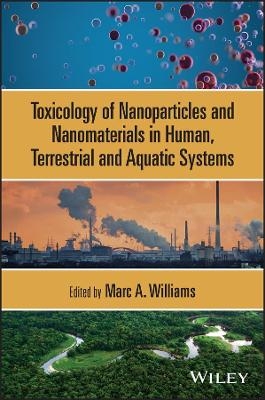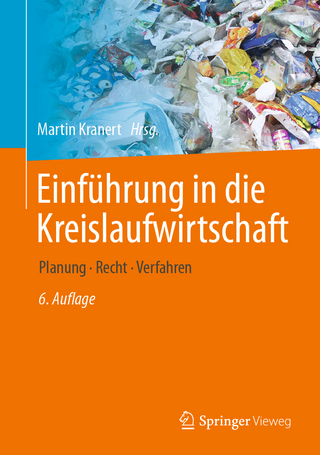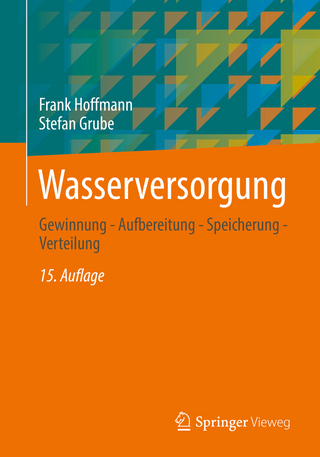
Toxicology of Nanoparticles and Nanomaterials in Human, Terrestrial and Aquatic Systems
John Wiley & Sons Inc (Verlag)
978-1-119-31633-6 (ISBN)
Toxicology of Nanoparticles and Nanomaterials in Human, Terrestrial and Aquatic Systems provides authoritative information on the toxicology of ultrafine and nanoparticulate matter that contaminate terrestrial or aquatic environments and present unique challenges in applied public health and toxicological research. Detailed chapters by a panel of world-renowned experts examine the complementary and dynamic interdependence of aquatic, terrestrial, and human systems and the toxicological impacts on exposure to engineered and manufactured nanoparticles and nanomaterials.
Organized into four sections, the book opens with a thorough overview of the field, including known challenges and the necessity for current research activity. The second section describes terrestrial and aquatic systems and the ecotoxicological impact of nanomaterials, followed by critical analysis of the many human health effects of nanomaterials. The book concludes with an in-depth discussion of current gaps in knowledge, future directions, new approach methodologies, alternatives to animal models, and the emerging environmental threat from nanoplastics. Presenting case exemplars of the ecotoxicological impact of nanoparticles in aquatic and terrestrial systems, this important resource:
Presents in-depth coverage of ecosafety, environmental behavior, fate and transport, interactive effects with other contaminants, and current challenges in soil nano-ecotoxicology
Addresses rising concerns regarding air pollution and neurological disorders, and the roles played by the gastrointestinal system, the mucosal microbiome, and the immunotoxicology and vasculotoxicity of metal-based nanoparticles
Provides detailed coverage of nanomaterial health effects from both animal and in vitro models, including the gut microbiome, innate immunity, neurological and cardiovascular impacts, mechanisms of action, and hazard characterization
Analyzes key topics in ecological nanotoxicology such as environmental micro- and nano-plastic pollution and applied risk assessment
Toxicology of Nanoparticles and Nanomaterials in Human, Terrestrial and Aquatic Systems is essential reading for toxicologists, applied biologists, ecotoxicologists, research scientists, medical professionals, regulators, and advanced students in fields such as public health, environmental ecotoxicology and medicine, immunotoxicology, neurotoxicology, cardiovascular and systems biology, hazard identification, and risk assessment.
Marc A. Williams, PhD, is an immunotoxicologist and Project Manager for Ecotoxicological Assessment, U.S. Army Public Health Center, Directorate of Toxicology, Aberdeen Proving Ground, Maryland. He is the author of more than 100 peer-reviewed articles, papers, book chapters, book titles, and scientific reports, with research interests in environmental toxicology, nanotoxicology, immunotoxicology and public health. Dr Williams is the Editor-in-Chief of Drug and Chemical Toxicology and a regular editor for Toxicology Letters.
List of Contributors xv
Foreword xxi
Editor Biography xxiii
Section I Introduction 1
1 A One Health Perspective and Introduction 3
Marc A. Williams and Gunda Reddy
1.1 Background 3
1.2 Structural and Logical Organization of the Book 9
Acknowledgments 15
References 15
Section II Terrestrial and Aquatic Systems 19
2 Ecosafety of Nanomaterials in the Aquatic Environment 21
Maria J. Bebianno, Thiago L. Rocha, José P. Pinheiro, Margarida Ribau Teixeira, and Fernanda Cassio
2.1 Introduction 21
2.2 Inputs of NMs to the Aquatic Environment 23
2.3 HowWastewater Treatment Processes Act in the Removal of Nanomaterials? 23
2.4 So What Is Expected to Occur in WWTPs Processes? 24
2.5 The Importance of Understanding Speciation of NMs 27
2.6 Ecotoxicological Effects of NMs in Freshwater Organisms 30
2.7 Ecotoxicological Effects of NMs in Marine Organisms 34
2.8 Interactive Effects of NMs with Other Contaminants 38
2.9 Environmental Risk Assessment (ERA) of NMs 42
Acknowledgments 43
References 44
3 Changes in Toxicant Physicochemistry and Bioavailability During Sorption/Desorption Processes with TiO2 Nanoparticles in the Aqueous Phase 59
Danae Patsiou, Martin R. S. McCoustra, Teresa F. Fernandes, and Theodore B. Henry
3.1 Introduction 59
3.2 Properties of TiO2 NPs in the Aqueous Phase 61
3.2.1 Agglomeration 61
3.2.2 Oxidation of TiO2 NPs by UV Radiation 62
3.3 Sorption of Organic Substances to TiO2 NPs 64
3.3.1 Influence of Organic Matter on Sorption 64
3.3.2 Influence of TiO2 NP Surface Area on Sorption 64
3.3.3 Use of Bioavailability to Inform on Sorption of Organic Compounds on TiO2 NPs 66
3.4 Conclusions 72
References 73
4 Behavior, Fate, and Toxicity of Engineered Nanoparticles in Estuarine and Coastal Environments 79
Daniel M. Lyons and Petra Burić
4.1 Introduction 79
4.2 Types of Nanoparticles: Sources/Products/Release Routes 80
4.3 Behavior of Nanoparticles in the Water Column 82
4.4 Biota, Trophic Transfer, Toxicity, and Mechanisms 84
4.5 Measurement Issues and Regulatory Environment 94
4.6 Modeling 94
4.7 Knowledge Gaps and Research Prospects 95
References 96
5 Interactive Effects of Nanomaterials with Other Contaminants on Aquatic Organisms: nTiO2 as a Case Study 101
Laura Canesi, Camilla Della Torre, Teresa Balbi, and Ilaria Corsi
5.1 Introduction 101
5.2 Interactive Effects of NPs with Other Contaminants in Aquatic Organisms: nTiO2 as a Case Study 104
5.3 Interactions Between nTiO2 and Other Contaminants in Marine Invertebrates: The Example of the Bivalve Mytilus 106
5.3.1 Effects of nTiO2 and Cd2+ 106
5.3.2 Effects of nTiO2 and TCDD 109
5.4 Interactions Between nTiO2 and Other Contaminants in Marine Fish: The Example of the European Sea Bass (Dicentrarchus labrax) 111
5.5 Interactive Effects of NPs with Other Contaminants in Marine Species: Importance of Exposure Media 114
5.6 Concluding Remarks 115
Acknowledgments 115
References 115
6 Soil Nano-ecotoxicology: What Have We Learned from Standard Tests and What May We Be Missing? 121
David J. Spurgeon, Elma Lahive, Carolin Schultz, and Claus Svendsen
6.1 Introduction 121
6.2 Development of Standard Test Methods and Their Application to Nanomaterials 122
6.3 From Soil Ecotoxicological Tests to Risk Assessment 127
6.4 Looking Beyond Standardized Tests Toward Effects in Ecosystems 128
6.4.1 Choice of Test Species 129
6.4.2 Short-Term and Long-Term Effects of Particle “Aging” on Toxicity in Natural Environments 131
6.4.3 How Soil Properties Interact with Nanomaterial Properties to Determine Bioavailability 133
6.4.4 Nanomaterial Bioaccumulation and Food Chain Transfer 135
6.4.5 Short-Term Tests Predict Long-Term Effects 136
6.5 Standard Ecotoxicological Tests: A Blessing and A Curse? 138
Acknowledgments 139
References 140
7 Impacts of Magnetic Iron Oxide Nanoparticles in Terrestrial and Aquatic Environments 147
Renato Grillo and Leonardo F. Fraceto
7.1 Introduction 147
7.1.1 Magnetic Nanoparticles and Their Properties 147
7.1.2 Commercial Importance and Applications of IONPs 149
7.1.3 Potential Toxic Effects of Magnetic Iron Oxide Nanoparticles 151
7.2 Gaps and Obstacles 155
7.3 Conclusions 158
Acknowledgments 158
References 158
8 Carbon Nanotubes: Sublethal Effects and Unique Mechanisms of Toxicity in Aquatic Species 165
Tara Sabo-Attwood, Christine Ngan, Candice Lavelle, Jaime Plazas-Tuttle, and Navid B. Saleh
8.1 Carbon Nanotubes in Aquatic Environments 165
8.2 Classical Toxicity: What We Have Learned 167
8.3 Unique Mechanisms and Effects 168
8.3.1 Nutrient Depletion 168
8.3.2 Immune Modulation 170
8.3.3 Influence on Co-contaminants 172
8.4 Next-Generation Nanomaterials: Nanohybrids 174
8.4.1 Variation in Nanohybrid Composition and Environmentally Relevant Properties 174
8.4.2 Toxic Responses Demonstrated by NHs 175
8.5 Future Perspectives 176
Acknowledgments 176
References 176
9 Surface Reactivity of Anatase and Rutile Samples: Relationship with Toxicity on Aquatic Organisms 187
Charlotte Hurel, Norbert Jordan, Ulrike Gerber, Stephan Weiss, Bernd Kubier, and Reinhard Kleeberg
9.1 Introduction 187
9.2 TiO2 Solid Phase Characterization 190
9.3 Potentiometric Titrations 194
9.4 Electrophoresis Measurements 196
9.4.1 In NaNO3 196
9.4.2 In Synthetic Freshwater (SFW) 198
9.5 Size Measurements of the Agglomerates 198
9.5.1 In NaNO3 199
9.5.2 In Synthetic Freshwater (SFW) 199
9.6 Ecotoxicity Tests 201
9.6.1 Rotifer Toxicity Test 201
9.6.2 Microcrustacean Toxicity Test 203
9.6.3 Diatoms Toxicity Test 204
9.7 Discussion 206
9.8 Conclusions 208
Acknowledgments 208
References 209
10 Cardiorespiratory Toxicity of Nanoparticles in Aquatic Environments 213
Christopher A. Dieni and Tyson J. MacCormack
10.1 Introduction 213
10.2 Cellular and Molecular Mechanisms of Engineered Nanomaterial Toxicity 214
10.2.1 Uptake-Independent Mechanisms 215
10.2.1.1 Accumulation on Cell Surfaces and Interference with Membrane and Transport Functions 216
10.2.1.2 Activation of Cell Surface Inflammatory Receptors 216
10.2.1.3 Uptake-Independent Generation of Reactive Oxygen Species 219
10.2.2 Uptake-Dependent Mechanisms 221
10.2.2.1 Disruption of Ion Transporters by Intact Nanostructures and Ion Products and Physiological Regulation 223
10.2.2.2 Activation of Systemic Immunity 225
10.3 Complement 225
10.4 Phagocytosis 226
10.5 Conclusions and Ecological Perspectives 227
References 228
Section III Human Systems 237
11 Air Pollution and Neurodevelopmental Disorders 239
Joshua L. Allen, Carolyn Klocke, Keith Morris-Schaffer, Katherine Conrad, Marissa Sobolewski, and Deborah A. Cory-Slechta
11.1 Air Pollution and the Brain 239
11.1.1 The Brain as a Target of Air Pollution 240
11.2 Air Pollution and Neurodevelopmental Disorders 241
11.2.1 Shared Co-morbidities of Neurodevelopmental Disorders 242
11.2.2 Potential Mechanisms of Air Pollution Associations with Neurodevelopmental Disorders 243
11.2.2.1 Microglial Activation and Inflammation 243
11.2.2.2 Ventriculomegaly, White Matter Damage, and Consequent Interhemispheric Dysconnectivity 244
11.2.2.3 Altered Glutamate and Dopamine 245
11.3 An Animal Model of UFP-Induced Developmental Neuropathology and Behavioral Disorders 245
11.3.1 Developmental CAPS Exposures of Mice Produce Male-Specific Microglial Activation 246
11.3.2 Developmental CAPS Exposures of Mice Produce Male-Specific Ventriculomegaly 247
11.3.3 Developmental CAPS Exposures of Mice Produce Male-Specific White Matter Tract Disruption 247
11.3.3.1 Corpus Callosum Size 248
11.3.3.2 Corpus Callosum Myelination 250
11.3.4 Developmental CAPS Exposures of Mice Elevate Glutamate Levels and Result in Male-Specific Excitatory–Inhibitory Imbalance 250
11.3.5 Developmental CAPS Exposures of Mice Are Associated with Impulsive-Like Behavior 251
11.4 Summary and Conclusions 253
References 256
12 Toxicity of Nanomaterials to the Gastrointestinal Tract 277
Penelope A. Rice
12.1 Introduction 277
12.2 GI Physiology and Toxicity Testing 279
12.3 Nanomaterial Toxicity Assessment: Challenges 286
12.4 Toxicity of Specific Nanomaterial Types 289
12.4.1 Titanium Dioxide 289
12.4.2 Silica 305
12.4.3 Nanosilver 311
12.4.4 ZnO Nanoparticles 319
12.4.5 Carbon Nanotubes and Fullerenes 327
12.5 Miscellaneous Nanomaterials 332
12.6 Analysis and Conclusions 337
References 338
13 The Mucosal Microbiome: Impact of Nanoparticles and Nanomaterials 353
Katherine M. Williams, Kuppan Gokulan, and Sangeeta Khare
13.1 Introduction 353
13.2 Types of Nanoparticles and Human Exposure 354
13.3 Factors Influencing Nanomaterial/Microbiota Interactions in the Intestinal Mucosal Environment 356
13.3.1 Nanomaterial-Specific Factors 356
13.3.2 Gut Environment-Specific Factors 357
13.3.3 Protein Corona 358
13.4 Nanomaterial Effects on Bacterial Microbiota 358
13.4.1 Metallic NM 361
13.4.1.1 Antibacterial Activity 361
13.4.1.2 Impact in Gut Models 362
13.4.2 Metal Oxide NM 363
13.4.2.1 Antibacterial Activity 363
13.4.2.2 Impact in Gut Models 364
13.4.3 Carbon-Based NM 364
13.4.3.1 Antibacterial Activity 364
13.4.3.2 Impact in Gut Models 366
13.5 Nanomaterial Effects on Viral and Fungal Microbiota 366
13.6 Conclusions 367
13.6.1 Antibacterial Activity of NMs 367
13.6.2 Evidence for NM Effects on Gut Mucosal Microbiota 367
13.6.3 Strategies for Assessing NM–Microbiota Effects 368
13.6.4 Direction for Future Research 370
13.6.5 Conclusion 372
References 372
14 Human Health Impacts and Immunotoxicology of Metal Nanoparticles and Nanomaterials – An Overview 383
Gregory P. Nichols and Jason Davis
14.1 Introduction and Background 383
14.2 Welding Fumes as Surrogates for Metal Nanoparticles 384
14.3 Immune-Related Health Effects 385
14.4 Oxidative Stress and Immunologic Effects 386
14.5 Conclusion 387
14.6 Immune-Triggered Human Health Effects of Metal and Metal Oxide Nanoparticles 387
14.7 Immune Interaction 387
14.8 Cellular Mechanisms of Injury 389
14.9 Oxidative Stress 389
14.10 Interaction with Cellular Membranes and Proteins 391
14.11 Disruption of Signaling Pathways 391
14.12 Immune Response 392
14.13 Immunosuppression 392
14.14 Inflammation and Autoimmunity 393
14.15 Sensitivity/Hypersensitivity 394
14.16 Summary 396
References 396
15 Vasculotoxicity of Metal-Based Nanoparticles 401
Maria S. Sepúlveda and Jiejun Gao
15.1 Nanoparticles in the Environment 401
15.2 Vascular Development 402
15.3 Critical Issues in Assessing the Toxicity of NPs 403
15.4 Vascular Toxicity of NPs In Vitro 404
15.5 Vascular Toxicity of NPs In Vivo 409
15.6 Movement of NPs Through the Blood Brain Barrier (BBB) 412
15.7 Conclusions 413
List of Abbreviations 413
References 415
Section IV Future Directions and Gaps in the Knowledge 423
16 Knowledge Gaps, Future Directions, and the Emergence of Nanoplastics as an Environmental Threat Pollutant 425
Marc A. Williams and Desmond I. Bannon
16.1 Current Concerns and Scope of the Problem 425
16.2 A survey of the Identified Knowledge Gaps and Needs for Future Research 427
16.3 Knowledge Gaps – Aquatic and Terrestrial Ecotoxicology 428
16.4 Knowledge Gaps – Adverse Health Effects in Humans 435
16.5 Emerging Threats and Future Directions 439
16.5.1 Nanoplastics – An Emergent Environmental Threat Pollutant 440
16.6 Conclusions and Other Considerations 444
References 446
Index 453
| Erscheinungsdatum | 01.09.2022 |
|---|---|
| Verlagsort | New York |
| Sprache | englisch |
| Maße | 10 x 10 mm |
| Gewicht | 454 g |
| Themenwelt | Naturwissenschaften ► Biologie ► Ökologie / Naturschutz |
| Naturwissenschaften ► Chemie | |
| Technik ► Maschinenbau | |
| ISBN-10 | 1-119-31633-2 / 1119316332 |
| ISBN-13 | 978-1-119-31633-6 / 9781119316336 |
| Zustand | Neuware |
| Informationen gemäß Produktsicherheitsverordnung (GPSR) | |
| Haben Sie eine Frage zum Produkt? |
aus dem Bereich


